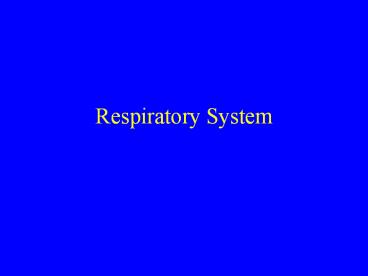Respiratory System - PowerPoint PPT Presentation
1 / 12
Title:
Respiratory System
Description:
Respiratory System Structure of Respiratory System 2 Lungs light, soft, spongy organs located in thoracic region; R lung larger than L b/c heart takes up space on ... – PowerPoint PPT presentation
Number of Views:74
Avg rating:3.0/5.0
Title: Respiratory System
1
Respiratory System
2
Structure of Respiratory System
- 2 Lungs light, soft, spongy organs located in
thoracic region R lung larger than L b/c heart
takes up space on L.
3
- 2 regions
- Conduction Zone - anatomical structures through
which air travels before reaching (upside-down
tree) - Respiratory Zone - region where gas exchange
occurs (alveoli)
4
Pathway of Air
- Nose/mouth
- trachea (windpipe)
- R L bronchi lungs
- bronchioles
- terminal bronchioles
- alveoli
5
Alveoli
- functional units of system 300 million tiny air
sacs in which gas exchange occurs (little bubbles
that are clustered like grapes) - Each alveolus is surrounded by network of
pulmonary capillaries gas diffusion (movement of
molecules from high concentration to low
concentration) occurs b/c of difference in
concentration between O2 (alveoli) and CO2
(capillaries). O2 heart CO2 exhaled
6
3 Phases of Human Respiration
- 1. Ventilation/breathing inspiration
expiration - 2. Gas exchange
- 3. Oxygen utilization by tissue for cellular
respiration - Changes in thoracic cavity during ventilation
occur due to activity of diaphragm external
intercostals muscles
7
Lung Volume
- Many factors influence the amount of air that
moves in/out of the lungs - - Body activities (sleeping vs. exercise)
- -Individual differences (sex, height,
age, weight) - -State of the lungs/respiratory organs (health)
8
Measurements of Air Volume
- Tidal volume (TV) amount of air moved in/out of
lungs with 1 breath (avg. 500mL) - Inspiratory reserve volume (IRV) amount of air
that can be inhaled forcibly over the TV (avg.
3100mL) - Expiratory reserve volume (ERV) maximum amount
of air that can be forcibly exhaled after a tidal
expiration (avg. 1200mL) - Residual volume (RV) volume of air that remains
in the lungs after a forced expiration (avg.
1200mL)
9
Measurements of Air Volume
- Vital capacity total amount of exchangeable
air TV IRV ERV (avg. 4800mL) - Total lung capacity sum of vital capacity
residual volume (avg. 6000mL) - Anatomic dead space a portion of air that
enters the respiratory tract never reaches the
alveoli remains in the air passageways (avg.
150mL) - Avg. volume reaching alveoli in 1 breath 350mL
10
Breathing
- rhythmic, involuntary process controlled by
respiratory centre of brain.
11
Factors that Effect Breathing
- Chemical changes in blood chemoreceptors
monitor O2 CO2 levels (hyperventilation results
during emergency situations when CO2 levels have
risen beyond normal) - Degree of stretch of lungs stretch receptors in
bronchi bronchioles activated during
inspiration cause expiration prevent lungs
from over-inflating - Persons mental state stress, fear, or pain can
? rate of breathing automatically some voluntary
control over breathing but cannot stop breathing
to the point of death (youd pass out first)
12
Mechanics of Breathing
- Brief demonstration of breathing mechanics
- Respiration Lecture































